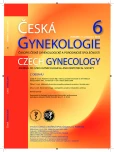The safety of home birth and evidence-based medicine
Authors:
P. Křepelka; P. Velebil
Authors‘ workplace:
Ústav pro péči o matku a dítě, Praha, ředitel doc. MUDr. J. Feyereisl, CSc.
Published in:
Ceska Gynekol 2012; 77(6): 555-558
Overview
Objective:
To review the available scientific evidence of perinatal outcome of planned home births and their reflection in the Czech Republic.
Design:
Review article.
Setting:
Institute for the Care of Mother and Child, Prague – Podolí.
Method:
An overview of recently published data.
Results:
Results of studies that evaluate the safety of planned home births are inconsistent and burdened by methodological limitations (selection bias, the absence of randomized trials, insuficient sample size and the lack of a control group). Evidence of argument that home birth is as safe as hospital birth, are insufficient. Consensual acceptance of home birth is conditioned by the exclusion of individual risk of complications, presence of qualified personnel and availability of emmergency transfer to hospital.
Conclusion:
Study of the safety of planned home births are methodologically limited and their results are inconsistent. Currently, there is no professional, organizational and legal framework for the management of planned home births in the Czech Republic.
Key words:
home birth, feto-maternal morbidity, perinatal outcome.
Sources
1. ACOG Committee on Obstetric Practice. ACOG Committee Opinion No. 476: Planned home birth. Obstet Gynecol, 2011, 117(2 Pt 1), p. 425–428.
2. Birthplace in England Collaborative Group. Perinatal and maternal outcomes by planned place of birth for healthy women with low risk pregnancies: the Birthplace in England national prospective cohort study. BMJ, 2011, 23, 343:d7400. doi: 10.1136/bmj.d7400.
3. de Jonge, A., van der Goes, BY., Ravelli, AC., etal. Perinatal mortality and morbidity in a nationwide cohort of 529,688 low-risk planned home and hospital births. BJOG, 2009, 116(9), p. 1177–1184.
4. Gyte, G., Dodwell, M., Newburn, M., et al. Estimating intrapartum-related perinatal mortality rates for booked home births: when the ‚best‘ available data are not good enough. BJOG, 2009, 116(7), p. 933–942.
5. Janssen, PA., Saxell, L., Page, LA., et al. Outcomes of planned home birth with registered midwife versus planned hospital birth with midwife or physician. CMAJ, 2009, 181(6–7), p. 377–383. Epub 2009 Aug 31.
6. Johnson, KC., Daviss, BA. Outcomes of planned home births with certified professional midwives: large prospective study in North America. BMJ, 2005, 330(7505), p. 1416.
7. Lindgren, H., Rådestad, I., Hildingsson, I. Transfer in planned home births in Sweden-effects on the experience of birth: a nationwide population-based study. Sexual & Reproductive Healthcare: Official Journal of the Swedish Association of Midwives 2011, 2(3), p. 101–105.
8. Lindgren, HE., Radestad, IJ., Christensson, K., et al. Outcome of planned home births compared to hospital births in Sweden between 1992 and 2004. A populationbased register study. Acta Obstet Gynecol Scand, 2008, 87, p. 751–759.
9. MacDorman, M., et. al. Births: Final Data for 2009. CDC National Vital Statistics Report. http://www.cdc.gov/nchs/data/databriefs/db84.htm
10. McLachlan, H., Forster, D. The safety of home birth: is the evidence good enough? CMAJ, 2009, 181(6–7), p. 359–360.
11. Mori, R., Dougherty, M., Whittle, M. An estimation of intrapartum-related perinatal mortality rates for booked home births in England and Wales between 1994 and 2003. BJOG, 2008, 115(5), p. 554–559.
12. van der Kooy, J., Poeran, J., de Graaf, JP., et al. Planned home compared with planned hospital births in the Netherlands: intrapartum and early neonatal death in low-risk pregnancies. Obstet Gynecol, 2011, 118(5), p. 1037–1046.
13. Wax, JR., Lucas, FL., Lamont, M., ET AL. Maternal and newborn outcomes in planned home birth vs planned hospital births: a metaanalysis. Am J Obstet Gynecol, 2010, 203(3), p. 243.e1-8. Dostupné na: http://www.ajog.org/article/S0002-9378(10)00671-X/fulltext . Citace [16.3.2012]
Labels
Paediatric gynaecology Gynaecology and obstetrics Reproduction medicineArticle was published in
Czech Gynaecology

2012 Issue 6
Most read in this issue
- Monochorionic biamniotic twins with a common yolk sac in the first trimester ultrasound scan – is there a higher risk of a congenital defect?
- Homebirth in Czech Republic
- Conservative method in treatment of placenta accreta – two case reports
- Dehiscence of laparotomy after hysterectomy – wound management
